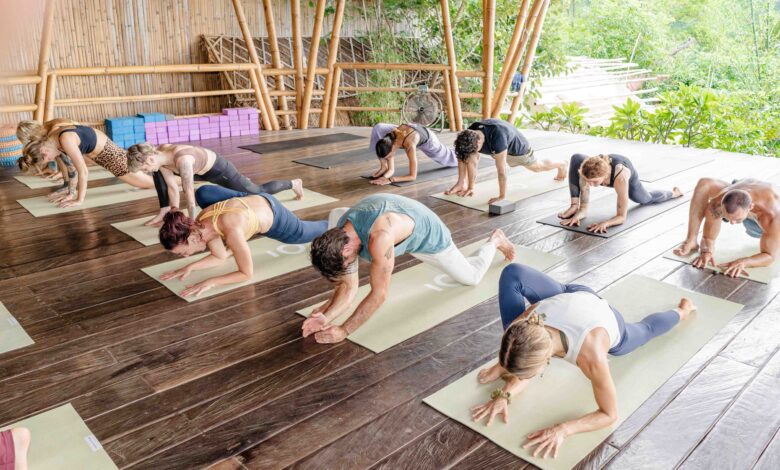The Art of Sequencing: Mastering the Flow in Yoga Classes with Insights from a 300-Hour Training in Bali

Yoga is much more than just a series of poses; it’s a holistic journey that harmonizes the body, mind, and spirit. One of the most crucial aspects of teaching yoga effectively is mastering the art of sequencing. This skill involves creating a logical and progressive flow that enhances the practitioner’s experience and maximizes the benefits of each session. Gaining profound insights into sequencing often requires advanced training, such as a 300-hour yoga teacher training in Bali. This article delves into the nuances of sequencing, enriched by the wisdom acquired from a 300-hour yoga teacher training course in Bali.
Understanding the Importance of Sequencing
Sequencing in yoga refers to the order and progression of postures (asanas) within a class. A well-structured sequence ensures that practitioners move through poses in a way that prepares their bodies for more challenging postures, promotes balance, and prevents injury. Effective sequencing also supports the mental and spiritual goals of a yoga practice, fostering a deeper connection to the self.
Physical Benefits
- Safety and Injury Prevention: Proper sequencing warms up the muscles and joints, gradually increasing the intensity to avoid strain or injury.
- Balanced Muscle Engagement: It ensures that opposing muscle groups are engaged and stretched, promoting overall muscular balance.
- Enhanced Flexibility and Strength: A progressive sequence helps in safely improving flexibility and building strength.
Mental and Spiritual Benefits
- Mindfulness and Focus: Thoughtful sequencing guides practitioners to stay present, enhancing their mindfulness.
- Emotional Release: It can facilitate the release of stored emotions through specific poses and breathwork.
- Inner Peace and Clarity: A well-sequenced class can leave practitioners feeling calm, centered, and more connected to their inner selves.
Insights from a 300-Hour Yoga Teacher Training in Bali
Attending a 300-hour yoga teacher training in Bali provides an immersive environment to deepen one’s understanding of sequencing. Bali, with its serene landscapes and rich spiritual heritage, offers an ideal backdrop for advanced yoga training. Here are some key insights from such a transformative experience:
1. Integrating Traditional Wisdom with Modern Science
A 300-hour YTT Bali program often blends ancient yogic traditions with contemporary anatomical knowledge. This holistic approach equips teachers with the ability to design sequences that are not only spiritually enriching but also anatomically sound.
- Traditional Wisdom: Incorporating elements like the chakras, nadis (energy channels), and the koshas (layers of being) into sequences.
- Modern Science: Understanding biomechanics and functional anatomy to create safe and effective flows.
2. Adapting to Different Levels and Needs
One of the hallmarks of advanced yoga training is the ability to tailor classes to various skill levels and individual needs. In a 300-hour yoga teacher training course in Bali, trainees learn to:
- Assess Practitioner Levels: Quickly gauge the experience and flexibility of participants.
- Offer Modifications: Provide alternative poses for beginners or those with injuries.
- Challenge Advanced Practitioners: Incorporate advanced asanas and transitions for seasoned yogis.
3. Thematic Sequencing
Themes add depth to a yoga class, making each session a journey rather than a routine workout. Themes can be based on:
- Philosophical Concepts: Integrating teachings from texts like the Bhagavad Gita or Patanjali’s Yoga Sutras.
- Energetic Focus: Centering the sequence around balancing specific chakras.
- Seasonal Changes: Adapting the practice to align with the natural rhythms of the seasons.
4. Emphasis on Breath and Pranayama
Breath is the bridge between the body and the mind. Advanced training in Bali emphasizes the integration of pranayama (breath control) into sequences. This includes:
- Synchronizing Breath with Movement: Ensuring that each transition and posture is linked with inhalation or exhalation.
- Breath-Centric Practices: Designing sequences that prioritize pranayama techniques to enhance energy flow and mental clarity.
5. Mindful Transitions
Transitions between poses are as important as the poses themselves. Smooth, mindful transitions maintain the flow of energy and keep practitioners engaged. Techniques taught in a 300-hour yoga teacher training in Bali include:
- Micro-Movements: Small adjustments that refine alignment and deepen the pose.
- Conscious Shifting: Moving with intention and awareness, avoiding rushed or mechanical transitions.
6. Incorporating Meditation and Relaxation
An effective sequence often includes elements of meditation and relaxation to provide a holistic experience. In Bali’s advanced training, teachers learn to weave these elements seamlessly into their classes:
- Guided Meditations: Short meditative practices at the beginning or end of the class to center the mind.
- Savasana Techniques: Enhancing the final relaxation pose with guided imagery or sound healing.
Practical Tips for Mastering Sequencing
Drawing from the comprehensive training in Bali, here are some practical tips for mastering sequencing in yoga classes:
Start with a Clear Intention
Before planning your sequence, set a clear intention for the class. What do you want your students to achieve or experience? This intention will guide your choice of poses and transitions.
Warm-Up Effectively
Begin with gentle movements and stretches to warm up the body. Incorporate poses that target major muscle groups and joints, preparing them for more intense postures.
Build Up Gradually
Progress from simpler to more complex poses. Ensure that each posture prepares the body for the next, building strength and flexibility incrementally.
Balance the Body
Include a variety of poses to ensure a balanced practice. Combine forward bends with backbends, standing poses with seated poses, and incorporate twists and inversions as appropriate.
Pay Attention to Alignment
Use cues and adjustments to help students maintain proper alignment. This prevents injuries and maximizes the benefits of each pose.
End with Cool Down and Relaxation
Conclude with poses that cool down the body and prepare it for relaxation. Incorporate a final relaxation or Savasana to allow the benefits of the practice to integrate.
Seek Feedback
After your class, seek feedback from your students. Understand what worked well and what could be improved. This continuous learning will refine your sequencing skills.
Conclusion
Mastering the art of sequencing is a journey that requires dedication, creativity, and a deep understanding of yoga’s physical and spiritual dimensions. A 300-hour yoga teacher training in Bali offers a profound opportunity to enhance this essential skill. By integrating traditional wisdom with modern anatomical insights, adapting to diverse practitioner needs, and focusing on mindful transitions and breathwork, teachers can create transformative yoga experiences. Whether you’re a seasoned yogi or a new teacher, advanced training in the serene environment of Bali can elevate your practice and teaching, helping you master the flow in yoga classes.



